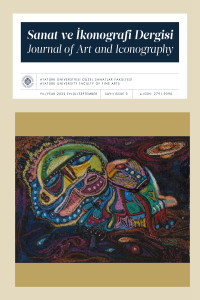GÖRSEL SANATLARDA ESTETİK
İnsanın güzellik ve beğeni anlayışıyla şekillenen estetik yargılarına rağmen, sanat eserinin estetik kriterler çerçevesinde değerlendirildiği bilinmektedir. Tıpkı estetik gibi ahlak ve güzellik kavramları da farklı dönemlerde araştırmacıların dikkatini çekmiş ve farklı bakış açılarıyla irdelenmişlerdir. Bazı bilim insanlarına göre güzellik, düşünme eylemi ile bazılarına göre de ahlak ile birlikte düşünülmüş ve tartışılmıştır. Tartışmalarla birlikte güzellik kavramı, kimi dönemler hazsal kimi dönemlerde de nesnel bir öge olarak tanımlanmıştır. Ancak güzelliğin tarihinde güzellik kavramına ilişkin tanımlar;dönemin, kültürün ve beklentilerin ışığında ele alınmıştır. Sanat alanında da sanat eserinin ön yapı (görünen) ve arka yapı (görünmeyen arka plan, anafikir) şeklinde iki açıdan analiz edilmesi; güzellik ve etik kavramının sanatçı, sanat eseri ve toplum üçlemesi içerisinde ve birlikte ele alınması dikkat çekicidir. Nitekim, kolektif yaşantının gereği olarak kurulan sosyal ilişkiler, yaşanılan durumlar, edinilen tecrübeler ve geliştirilen düşünme biçimlerinin de sanatçıyı şekillendirdiği ve doğal olarak sanat eserini de etkilediği düşünülmektedir. Toplumun genel beğenileri ve kültürel değerlerini yansıtan Türk estetiğininde sadece Türk sanatçıların eserlerinde değil mimariden her türlü tüketim ürünlerine kadar tüm tasarım alanlarında baskın ve ayırtedici bir özellik olarak görülmesi beklenmektedir. Türk estetiğinin toplumsal, kültürel ve sosyal yaşantılar çerçevesinde ve21. yüzyılın yeniliklerine uyum sağlayarak varlığını devam ettirdiğini ifade etmek mümkündür.
Anahtar Kelimeler:
stetik, Güzellik, Sanat, Türk Estetiği
Aesthetics in the Visual Arts
It is known that the work of art is evaluated within the framework of aesthetic criteria, despite the aesthetic judgments of people shaped by the understanding of beauty and taste. Like aesthetics, the concepts of morality and beauty have attracted the attention of researchers in different periods and have been examined from different perspectives. According to some scientists, beauty has been thought and discussed together with the act of thinking, and according to others, with ethics. Along with the discussions, the concept of beauty has been defined as hedonistic in some periods and as an objective element in other periods. However, the definitions of beauty in history are discussed in light of the period, culture, and expectations.In the field of art, the work of art is analyzed from two perspectives as the front structure (visible) and the back structure (invisible background, main idea); It is noteworthy that the concepts of beauty and ethics are handled together in the trilogy of the artist, work of art and society. It is thought that the social relations established as a requirement of thecollective life, the living situations, the experiences gained, and the ways of thinking developed also shape the artist and naturally affect the work of art. It is expected that the Turkish aesthetic, which reflects the general tastes and cultural valuesof the society, will be seen as a dominant and distinctive feature not only in the works of Turkish Artists but also in all design areas, from architecture to all kinds of consumer products. It is possible to state that Turkish aesthetics continue to exist within the framework of social, cultural, and social experiences and by adapting to the innovations of the 21st century.
Keywords:
Aesthetics, Beauty, Art, Turkish Aesthetics,
___
- Akgün, M. Z. (1978). Çeşitli yönleri ile Baltacıoğlu.Yeni Adam, (92):38-43.
- Arda, Z. (2015). Aşk estetiği ve resim.İdil Sanat ve Dil Dergisi, 4(16):81-106.
- Aslan, İ. (2017).Mu’tezile rasyonalizmi üzerine.İslami İlimler Dergisi, 12(2):81-102.
- Doğan, M. H. (1998). Estetik. Dokuz Eylül Yayınları. Francalani, E.L. (2012). Nesnelerin estetiği.(Durdu KundakçıÇev.).Dost Kitapevi.
- Koç, T. (2008). İslam estetiği, İSAM Yayınevi.Read, H. (2014). Sanatın anlami, (Nuşin AsgariÇev.).Hayalperest Yayınevi.
- Tunali, İ. (1997). Estetik. Remzi Kitabevi.
- Vigarello, G. (2013). Güzelliğin tarihi, (Erkan AtaçayÇev.).Dost Kitabevi.
- Başlangıç: 2021
- Yayıncı: Atatürk Üniversitesi
